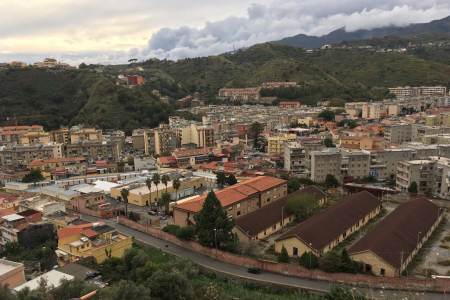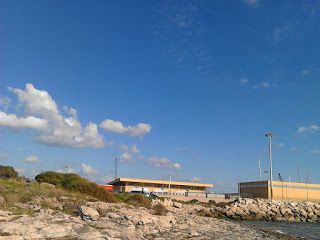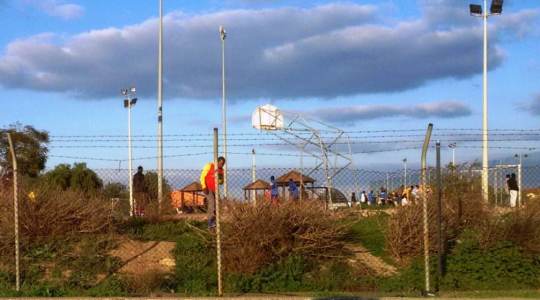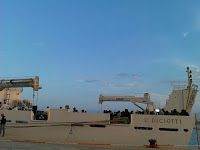Visit to the former barracks of Gasparro in Bisconte, Messina
On
the 7th of March we have entered the former barracks of Gasparro in
Bisconte (or ‘ex-caserma’ in Italian) together with a couple of
activists of Messina and with Francesco D’Uva, a congress man of the
Movimento 5 Stelle. We arrived around 17.00 o’clock and found the door
open, the entrance guarded by a surveillance officer. Before our visit
we have collected general information from the supervisor of the
managing authority, the ARCA association of Trapani, about the residents
currently present in the facility. In total there are 198 men in the
age between 18 and 25 year, who are mostly coming from Gambia, Mali,
Nigeria and Senegal.
The average duration of residence is 30 days. To the question what the
juridical nature of the centre is they respond that it is a CPA (centre
of first accommodation)*. In theory the staying time of migrants in this
kind of structure should only be the necessary one for the
identification and transfer, with a time limit of 72 hours.
When entering the building we pass two containers of sanitary
facilities. With respect to the privacy of the residents we only look at
the external part of the toilets and we encounter poor hygienic
conditions, with stagnant water on the floor and a bad smell coming from
the drains.
We then enter the first of three big rooms of the
ex-caserma: it is the smallest one and it counts 28 beds (some of them
bunk beds, others single ones) on a surface of 10 x 10 metres. It looks
to us that this is a case of overcrowding, but to find ourselves in an
even worse situation we only have to enter the other two rooms in which
there are the remaining circa 170 beds, all crammed on a surface of 10 x
18 metres. In these rooms the rows of beds, the greater part bunk beds,
are set out on the perimeter and even in the centre of the room.
Between some of the beds there is not even place to walk. The smell that
characterises these rooms is very strong and privacy is non-existent.
While we make our inspection round some of the residents are sitting on
their beds or are asleep; one of them, apprehending the reason of our
visit, asks us to tell the managers to set up an Italian language
course, because he has been there since circa a month but so far has not
been able to learn. We find other young residents in the room arranged
as a praying place whilst others play some football in the outside area.
We get to the local canteen where others are watching
television. The space is definitely small in comparison to the number of
people that have to make use of it and predicts long queues at the time
of the distribution and consuming of the meals.
Also the room
used as an infirmary does not present itself well at all: it gives the
idea of an abandoned place where the medicines are scattered all over
and the hygiene conditions are scarce, something not at all adequate for
the destination of the place. The supervisor of the centre explains us
that the service of medical care is performed on alternating days with
the Pala Nebiolo** by a private doctor who works in direct contact with
the Health Authority, to which he communicates on a daily basis how many
visits have been paid and any diseases found. There are no opening
hours of the infirmary but the practitioner stays as long as necessary
to examine everyone that shows up and receives a payment from the
managing authority corresponding to the worked hours.
Continuing our tour we have the possibility to see the sanitary
facilities inside of the building that right at that moment are about to
be cleaned by the cleaning staff. Their condition turns out to be okay,
but in the complex there seem not to be enough bathrooms: added up to
the ones outside there are in total circa a dozen toilets and a dozen of
washbasins and showers.
When we ask for explanations about the
clear overcrowding of the rooms, the answer of the supervisor is that
the Prefecture conducts monthly inspections and that the last visit from
its representatives to the centre dates back to February 21. This means
that according to the parameters of the governmental Territorial
Office, the present situation at the CPA falls within the standards of a
decent and wholesome accommodation, given that this is envisaged by the
same Convention of custody of accommodation, which considers a capacity
of 200 residents for the ex-caserma of Bisconte and 250 residents for
the Pala Nebiolo.
It is therefore hard to understand the
meaning of the parenthesis that stands out on the announcement of the
contract notice published by the Prefecture of Messina on which, in
relation to the requested capacity of the structure, it is specified
that capacity limit is “set in relation to the need of assuring uniform
standards of accommodation in such facilities”.
In the former
barracks of Bisconte, which based on its juridical nature should only be
used as a transit place, the provided services are cut to the bone. The
working staff is divided between Pala Nebiolo and the ex-caserma of
Bisconte and is made up by two linguistic-cultural operators/mediators, a
psychologist, an Italian teacher and a social worker, who thus have
taken in care around 450 individuals. According to the supervisor also a
legal consultant is part of the team and he should assure the
disclosure within 48 hours after the arrival of the migrants. In this
respect it is worth remembering that, as reported by the assembled testimonies
of residents met outside Pala Nebiolo on January 30, no one had ever
received any legal information, not even those who had been staying in
the tent camps for over a month. Unclear as well is the presence of an
Italian language course that should have been assigned to a voluntary
teacher who, when she can find time for it, makes all the efforts
between one centre and the other.
The structural
characteristics and the lack of services that typify this CPA outline an
accommodation of a compressing sort that is not only in violation with
the law and the dignity of the people but in light of lengthy residence
also has severe consequences for the lives of the migrants.
On
this point the situation of the twenty asylum seekers who have
collaborated with the investigations to identify the traffickers there
at the moment of disembarkation is particularly disturbing, since they
have to remain in the CPA in waiting to be heard by the judge. These
people, instead of getting protection guaranteed by the law, are in fact
condemned to stay in this non-place for a very long time, in conditions
of total neglect.
The most worrying case is that of a
testifier that is already staying in the CPA for a good seven months.
Not having been heard by the judge yet he does not know how much time
has to pass before his transfer to an accommodation centre is arranged.
To the question how many times he has met the judge his answer is:
“Never”.
The twenty migrants in question are the only ones who
were able to formalise the request for protection, while the others will
only be given opportunity to present it when they have been transferred
to other facilities. So the prolongation of a transitory accommodation
corresponds to the extension of the time to access the procedure for
asylum application, which will be another cause of the prolongation of
the waiting time for the hearing of the County Committee.
We
then request information about where and how these people are
identified: all the identifications take place at the moment of arrival
at the immigration office of the police station set up inside the Pala
Nebiolo. Only afterwards the migrants are transferred to the buildings
of the ex-caserma Gasparro of Bisconte. When we ask what the
consequences are if one were to deny to provide samples of digital
fingerprinting, the answer is clear: “Nobody leaves Pala Nebiolo without
having left fingerprints”. Also with regards to the procedure of taking
digital fingerprints at Pala Nebiolo, we refer to our report of January 30.
Ultimately there is a last important concern to point out with respect
to the managing of the accommodation of the CPA ex-caserma Gasparro of
Bisconte which we have already specified in the report
relating to the visit last October to the former retirement home of
Sant’Alessio, opened for the accommodation of unaccompanied minors. In
fact we know that the ex-caserma of Bisconte is used as a place to
accommodate those who just have reached the age of majority and who,
after having spent a period of multiple months in facilities intended
for the accommodation of unaccompanied minors with an emergency decree,
are being transferred here: hence passing from the circuit of the first
emergency accommodation to the very first accommodation.
We can
confirm the existence of these practises with certainty because we have
been able to follow the bureaucratic procedures of some of the
unaccompanied minors directly; we first met them in the Gravitelli gym
on October 13, have met them last month in the former retirement home of
Sant’Alessio, to which they were transferred in the days following our press release of October, and now finally we have seen them here in the ex-caserma on the 7th of March.
It was in fact one of them who recognized us. We had seen each other a
month ago at Villa Solaria, where he had spent a good seven months,
after which he has been transferred to Bisconte the day after coming of
age. He says that he is here now because “end of child”. He also adds
that he does not like this place and that he even does not go to school
anymore while before he went there every day.
Upon completing
the visit, congress man D’Uva has been in touch with the Prefecture to
hear about the fate of the ex-caserma Gasparro, receiving on one hand
the denial of it having an active hotspot and on the other hand the
confirmation of an extension in order to create a super-hub.
Giovanna Vaccaro
Borderline Sicilia
*CPA – Centro di Prima Accoglienza: Centre of primary reception
** Pala Nebiolo – former baseball stadium
Translation: Marieke Ruytenburg




